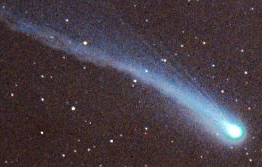
I guess it gives a whole new spin to the phrase "Decoding the Heavens". I just went to a press conference here at the AAAS meeting at which Anthony Remijan of the National Radio Astronomy Observatory talked about using a radio telescope to sweep the sky for signs of complex organic molecules, to gain clues to how life first formed.
Scientists have spotted large molecules in space before, including sugars, alcohols and even antifreeze (ethylene glycol). But generally they had to decide what molecules they were looking for, then look for the particular radio signatures (called "spectral lines") emitted by those molecules. That works fine, but you can only find what you were already looking for. Remijan and his colleagues tried a new approach. They used the powerful Green Bank Telescope in West Virginia to scan a star-forming region near the centre of our galaxy across a wide range of radio frequencies. Remijan said they've found more than 720 spectral lines from a whole range of molecules, including 11 never seen in space before. Around 240 of the spectral lines come from molecules that still have to be identified.
The researchers have made the whole dataset available online, so anyone who's interested can start sifting through it for evidence of new chemistry. Molecules already identified by the survey include cyanoallene, methyltriacetylene, cyclopropenone and methylcyanodiacetylene - all quite complex carbon-based molecules, with lots of double and triple bonds.
What I find most interesting about all this is how it changes our perception of where the chemical precursors of life came from. Remijan mentioned the famous Miller-Urey experiment conducted back in 1952 here in Chicago. Stanley Miller and Harold Urey built apparatus that simulated the precise atmospheric and chemical conditions thought to be present on the early Earth. It produced several molecules thought to be precursors of life, including some amino acids. The assumption was that these precise conditions on Earth were necessary for these molecules to be formed, but scientists are increasingly discovering that there's all sorts of complex organic chemistry going on in outer space, including the formation of pre-biotic molecules. These molecules probably form on the surface of interstellar dust grains, then are carried onto planets by comets and meteorites.
A second talk in the same press conference also suggested that the universe is quite a bio-friendly place. David Wilner of the Harvard-Smithsonian Center for Astrophysics and his colleagues have been using the Submillimeter Array Telescope in Hawaii to look at dusty disks surrounding nine young stars in the constellation Ophiuchus. They wanted to know whether the material in these disks was distributed in the right way to form planetary systems like our own. They found that in all cases the disks were just right for making planets. What's more, two of the nine disks had a hole in the centre, suggesting that the dust had been cleared away by young planets already formed. So planetary systems forming around stars could be the norm, rather than the exception. And where there are planets, there's the possibility of life.